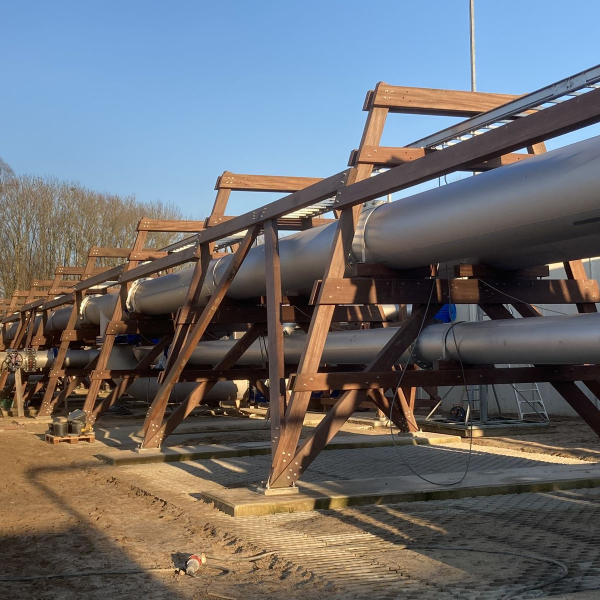Design of circular WWTP in Terwolde
Towards climate-neutral assets

Design of circular WWTP in Terwolde
The Terwolde wastewater treatment plant is one of the first circular WWTPs in the Netherlands. By implementing circular design principles, among others, the Vallei en Veluwe water authority has taken an important step towards achieving a fully climate-neutral asset. Among other things, the project has shown that the design process proceeds at the same pace as with a mainstream project.
Most water authorities are facing a large-scale replacement and renovation programme, since many wastewater treatment plants are nearing their end-of-life. While at the same time, a CO2 emission reduction of 55 % by 2030 and 100 % by 2050 must be achieved in line with the Climate and Raw Materials Agreement to which companies and governments have committed. This has implications for the design, construction and operational phase of WWTPs, for example, in the use of fewer primary raw materials. The question, however, is: how to organise the design process such that the client, which is the water authority, can take the right decisions based on measurable data?
Driving force for sustainability
Witteveen+Bos was part of the collaboration Combinatie Lokaal Circulair (CLC) in the project, as were Pannekoek GWW, ADS Groep and Moekotte. Together with the Vallei en Veluwe water authority and Royal HaskoningDHV, CLC formed the construction team.
The construction team was responsible for the implementation of circularity and sustainability. The water authority’s invitation to tender, which focused on sustainable/circular solutions, was the driving factor. The construction team gradually shaped the design of the WWTP (the treatment plant as well as the other assets on the site). Witteveen+Bos’ circularity and sustainability expert acted as a ‘driving force for sustainability’.
CO2 reduction per euro invested
A crucial factor in the design process is the consideration of more sustainable, circular design alternatives based on quantifiable information. These alternatives are weighed against a new-build alternative, considering the entire life cycle.
The latter is important because the WWTP’s carbon footprint depends for 80 % on the operational phase. Several factors come into play in the consideration process. It is not just about CO2 emissions, but also about technical and economic feasibility. A key factor is the relationship between cost and CO2 reduction; in other words, how much CO2 can you reduce per euro invested?
Understanding this is necessary to achieve support for the design within the organisation. A more expensive alternative with a significantly positive environmental impact, for instance, is more likely to be approved if it is based on sound calculations.
Calculation tools
Witteveen+Bos has used several calculation tools to run through the design alternatives and benchmark them against a new-build alternative. They were assessed on circular and sustainable KPIs (MCI, ECI, and CO2 eq). The entire footprint was identified by means of an LCA analysis, leading to the determination of the Environmental Cost Indicator (ECI).
We linked these calculations to the Building Information Model (BIM). The ECI was calculated using DuboCalc, the calculation tool of DuurzaamGWW. The LCA was conducted in the industry-standard software SimaPro. The Material Circularity Indicator (MCI) was determined using the +Circular Design Tool of Witteveen+Bos. We align with industry standards for calculation rules and databases in these calculations; i.e. for WWTP Terwolde, among others, Circular Building Platform 2023 (CB’23) and the National Environmental Database (NMD).
Modular design
What specifically does a circular approach mean for WWTP Terwolde? This is reflected in the design, the use of raw materials (e.g. reuse) and anticipation of the option to ‘harvest’ raw materials from wastewater. In terms of design, the water authority opted for the Verdygo® concept. This divides the treatment plant into separate, standardised modular components. This results in an effective treatment plant with a capacity that is relatively easy to adapt to future situations. The plant also allows for adding process steps, such as filtering out by-products (e.g. cellulose) which can be reused (e.g. in finished products) as well as the removal of micro-contaminants.
Remountable design
The pipe bridge and office building on the Terwolde site were also designed in accordance with circular design principles. However, rather than steel, as is customary, the bridge was made of wooden elements. W+B’s calculations showed that although the wooden bridge was more expensive, its carbon emissions and ECI were significantly lower. This argument carried more weight with management, so they opted for the wooden variant. The higher costs were covered by savings achieved in other parts of the design through the use of sustainable solutions, such as reusing existing parts. For the office building, they opted for a remountable design and the use of second-hand materials where possible.
Iconic project
The circular design of the Terwolde WWTP is the first of its kind and serves as an example for the entire industry. The project was used as an iconic project in the Union of Water Authorities’ Climate-neutral and Circular Asset Management and Contracting (KCAO) platform.
The project generated insights from which similar projects can benefit. In the design phase, for instance, it became clear that circularity should not be following the lead but be leading itself. Ideally, the design alternatives follow the same path. Based on quantifiable information, policy-makers can make measured decisions to maximise return in terms of CO2 emission reduction per euro invested.
Not an end, but a means
A circular approach is a means to achieve sustainability and not an end in itself. Ultimately, it is about fulfilling the ambition of being climate-neutral, to which the government and business community have committed. Unfortunately, circular solutions are not yet available for all situations.
Finally, a circular approach requires a different mindset in organisations. Conservative, risk-averse behaviour will have to give way to an open, inquisitive approach. Standards are there to be adapted without sacrificing function or safety. For instance, raw materials partly composed of recycled materials can have the same functional properties as new, ‘virgin’ materials. It is a continuous quest towards net zero.
More information?
